As I mentioned earlier, I am in the first semester of a year-long immersive learning project, and my students this semester are prototyping board and card games on themes of environmentalism and sustainability. My friend and colleague Joshua Gruver gave a guest presentation to the students, during which he presented some formal models of sustainability and chilling stories about what happens without it. One of the memorable models was the three-legged stool, which defines sustainability as having three legs: environmental, economic, and social. That is, to be sustainable, you have to have all three in balance.
A moment's reflection will reveal that the economic leg is the one that seems never short-changed in business decisions, and so dedicated effort is required for the other two. This feels inevitable if we describe businesses' role as being that of economic drivers. I think it is much less common to frame businesses as engines of environmental and social welfare. A modern accounting framework like triple bottom line gives some tools for how environmental and social aspects could—perhaps, should—be considered. However, I cannot feel a bit pessimistic, since these kinds of models only seem fair if everyone plays by the same rules, and you cannot make everyone play by the same rules.
All the more reasons to have some educational games to teach people about it!
I've been starting to sketch out some game designs based around the three-legged stool model, and it's making me look more critically at how the three elements of economic, social, and environmental are dealt with in contemporary games. Power Grid is a great example, as it provides both a compelling, modern theme along with a convincing economic model of resource scarcity. Scarcity drives up prices for fuel, at which point clean energy sources—which are initially very expensive—begin to give better return on investment. Notice that this treatment is still entirely economic! There is no consideration of environmental impact of pollution: only the price of fuel matters. Similarly, there is no consideration of the human cost of any of this activity: if some people don't get power, it doesn't matter. The fact that people are involved in the gathering and processing of fuel is completely absent. Of course, Power Grid is not about these thing: it's about efficient German boardgaming. However, it provides a good example of how only the economic side is modeled.
I had to stretch to find any games that consider social aspects. One good example is Above and Below: in this game, when you have workers exploring the caves, you can elect to injure them in order to get better results. When they are injured, it takes them longer to recover. Your faithful workers never consider rebellion or revolt, however: you can, and probably should, hire lots of workers so that you are free to injure them and still have ready workers the next round. Village has a different spin, where workers "age", and over time, your oldest workers must die. There's a beautiful little system around this that models generations of families in a medieval village. Puerto Rico famously avoids social issues by encouraging you to bring more and more little brown interchangeable "colonists" to work on your plantations. I know some people find this offensive, but I lean toward seeing it as a learning opportunity: by choosing the play the game, you get caught up in an economy that dehumanizes your workers, and the only way to win that game is to bring in more and more colonists to keep up with others who do so. Stepping outside the game, the only way to stop the sale of African slaves to plantations was for a critical mass of people to decide not to play that game.
My favorite representation of social elements in game design is in the short-form roleplaying game, Dog Eat Dog. There's so much brilliance in that design, but let me share my favorite aspect. The game models colonialism in the Pacific islands. All the players but one are natives, and one player represents the colonial forces. When the natives are together, they are individuals, with names, roles, and identities, but when the colonial forces are in a scene, the natives become homogeneous—they become all the same, interchangeable, merely pieces of someone else's game.
[EDIT] In my original draft, I forgot to mention Archipelago, but it merits some special attention. It deals with the difficult economic+social theme of colonialism in the Pacific islands as well. It is a semi-cooperative game in which each player tries to win individually, but all can lose collectively if the natives revolt. By growing the economy, players contribute to the population's general unrest. This unrest is a shared resource and always visible. In the games I have played, the most common way to reduce unrest is to hire natives, reducing the number of available workers. Once you hire the natives, they become indistinguishable from the colonists you brought with you, and fewer available workers means less unrest is generated. This is a very interesting spin on the theme. Like many games for entertainment, the game does not challenge you to consider what this means: you simply take the actions afforded by the game in order to move closer to victory. [/EDIT]
Turning to environmental matters in games, it's hard to find any good representations at all. In 4X games like Civilization, there are always limited resources, but these are really just economic models: you get the resources when you can, and when you cannot, you trade for them or fight over them. There is no consideration of conservation: natural resources are to be taken and used as quickly and efficiently as possible. Resource management games like Stone Age or Settlers of Catan provide essentially limitless resources, sometimes of varying scarcity, but there is no consideration of policy or land management. I enjoy Dominant Species for how it handles the evolution of species' dependencies around a changing environment, but the decisions about environmental resources are entirely tactical and selfish. Maybe I'm missing something, but it seems to me like there is a great opportunity here, a potentially untapped design space to model something like environmental policy. The cynical designer may even make it a hidden traitor game.
Let me bring this back to my initial design explorations. My sketches were looking at a system inspired by Tigris & Euphrates, where one would collect different kinds of points—economic, social, and environmental, naturally—and the winner would be the one with the most balanced system at the end of the game. I love this aspect of Tigris & Euphrates, that it doesn't matter who has the most of anything, but rather, you try not to be the one with the least of anything. As I started sketching out some systems, it's pretty clear that there are lots of economic systems that could be deployed, and a player could earn points for good economic choices. Then, I started thinking of social and environment issues, and my first reaction was to treat them punitively: if you force your workers to work overtime, you lose social points, or if you take all the wood off of a forest, you lose an environmental point.
Think about that! Economic points are earned by taking positive action, but environmental and social points are lost by taking "bad" actions. That's the imbalance of the three-legged stool! What I see as a reasonable expectation of default perspective on the issue frames these three choices as complete opposites. Of course, it's not the case that social good is earned simply by not exploiting people, or that environmental good is earned by not exploiting land.
I'm not sure where these design sketches will go from here, but I figured it would be worth sharing some of my thoughts here. I would like to carve out some time tomorrow or next week to put a minimal prototype together and show it to my students, to see if any of this inspires their designs. In the meantime, if you know of games that have good representations of the environmental or social aspects of sustainability, please share them in the comments or send me an email.
Thursday, October 13, 2016
Tuesday, October 11, 2016
Painting Myth
Over the summer, I met a colleague for coffee to talk about research, and the conversation turned to board games. He told me that one of his favorite games is Myth, by Megacon Games. I had heard of this one for two reasons: it was an early Kickstarter success in miniature-driven board games, and it is developed by an Indianapolis-area company. I decided to check out the Megacon booth at GenCon a few days later, and I was impressed by their display and friendly staff. Normally I attend GenCon to enjoy the sights but don't actually buy anything, but this year I ended up taking home a copy of Myth along with a con bonus Trickster hero. I gave the game a spin with my wife and son, and it was pretty rocky on the first go, but we still had fun, and so I decided to make it my next painting project.
The first decision I had to make was what to do with the bases. Most board game miniatures come with plain bases, but Myth figures are on strangely-sculpted bases. Here's one of the textured ones, although others combine this motif with chunks of flagstone.
Some folks have just painted these as-is, but I wasn't sure I liked the look of them. Others went all-out custom sculpt, which looks amazing, but I didn't want to spend that much time on them. I still have a small box of custom ballast mix that I used on my last painting project, so I tried just gluing that down and drybrushing it, and that worked fine. You'll see this in the finished photos below.
This was around the time that Ghool starting posting painting videos regularly to YouTube, and many of these feature characters from Myth. His paint jobs are amazing, although somewhere he mentioned that the minions would be well-served by a simple base coat and shade. Good enough for Ghool is good enough for me! I started in with the crawlers.
Looking at the unpainted ones originally, it was hard to tell that there even were different sculpts; painting the ranged crawlers with green poison glands makes them much easier to pick out on the table and in the box. Also, I should mention that with all the figures in this set, I am mostly following the color schemes on the card art. These crawlers were done with light highlighting after the base coat and wash, which gave them a much livelier appearance than before. For the bases, I didn't even flock them, because I wanted them to look like they could be on barren earth or in a cave, and I think it turned out fine.
Similar approach used for the grubbers: base coat in muted green with a dark green wash, various browns for the cloth shaded with darn brown wash. After this they looked a bit too dark, so I went in and added two highlights quickly to the skin. Even though it was a little sloppy, it added a lot of "pop" to the figures.
Now, away from the minions and on to the captains!
These stalkers gave me a great opportunity to practice smooth blends on curved surfaces using two-brush blending. The color scheme is really wild, much bolder than what I usually paint, and this made it something of visual treat for me. (This is also where I found the new white balancing feature in Snapseed. The previous pictures were re-balanced from the originals.)
Next up are the muckers, who—as we all know—are the bosses of the grubbers. Also, it appears they are the masters of the do-si-do. I was able to match the skin tone well with their smaller kin, but these were painted with much more care, using two-brush blending across most of the figures. I thought about varying the paint scheme on them since there are two, maybe changing the color of their towel/stole/scarf, but I decided to just keep them the same for expediency. It's hard to imagine a game situation where I will regret that, but we'll see.
Back to the insects, I moved on to the Terror with 1,000 Legs—the "big bad" of the Myth base set. Again, lots of two-brush blending over big, curved areas, and I think it looks pretty good. The pale maggots were fun to paint as high-contrast against the red-brown Terror.
One thing you cannot tell from the pictures is that my Terror was quite badly affixed to its base. All the miniatures in Myth come pre-assembled and attached to their bases, and although the assembly is generally good, some of them were poorly attached to the base. The Terror in particular was about 2mm higher on one side than the other. Originally I tried sculpting a base from Milliput to compensate, but it was its left side that was higher—the side with the maggot at ground level. The result, then, was an odd little shelf that held the maggot off the side, and it looked too goofy. I chipped the Milliput away and used my new razor saw to cut the creature right off its base and, together with my files, level off the bottom of the Terror. I pinned the terror to the base in three places and filled the gaps and base with brown-tinted fine pumice gel.
Here's a bonus picture of the Terror and some crawlers. I like that the tones are similar yet different, with the larger one being darker.
After the big bad, it was time for the core set's lone mini-boss and only undead, Yardu. For this model, I ended up going back to layering rather than two-brush blending. I have some sense now for both techniques, and I should look for more places to reflect on which one I should use in which circumstances. One thing I've noticed is that I find it easier to place shades effectively when starting with a base coat as in two-brush blending, whereas with layering, I will sometimes "miss" my target base color by either having too much shade/highlight or by a paint mixing error. (Keep in mind that I mix all my colors from a relatively small selection of paints.) Anyway, I am happy with how Yardu looks. How can you not like a skeletal guy who carries human skulls and also paints skulls on his knees and hey that's not enough let's also paint a skull on my helmet?
That's all the villains, so I moved on to the heroes, starting with the two that my son and I were most interested in playing: the Brigand and the Apprentice. Coincidentally, these are the two featured in some of the gameplay videos (starting here) produced by Megacon Games.
First was the Brigand, a kind of a throwback to my Mice & Mystics set. What I've learned since then! Anyway, I had some trouble matching the main fur color with this miniature, and it took several tries to get something that I liked. Here, he may lean a bit more toward grey than some of the artwork, but I think the end result still looks good. No real tricks here. The miniature did not have strongly detailed fur, unlike, say, the wookie from Imperial Assault, so washes were not bringing out much of the texture. I found that highlighting little tufts with short strokes was effective enough for this guy.
The apprentice was a lot of fun to paint, having a simple bold color scheme. Reds don't intimidate me like they used to since I have learned a lot of tricks for dealing with them. The highlights on the Apprentice lean slightly toward yellow, and deep shadows on the muscles produce good contrast. The white pattern was painted in layers, starting with a light grey and then brightening up only the parts where an overhead light source would reach, and this helps communicate the texture on his torso.
I don't know if my original figure was bent or not, but the miniature was leaning way back. Looking around at others' figures, it's not clear to me if that was how it was supposed to be or not. In any case, I didn't care for it and I wanted to reinforce the join anyway, so I chopped him off and pinned him back on more upright.
Usually with these projects, I wait until the whole set is completed before letting them hit the table, but my son and I were to eager. Here's a shot of our first game with painted figures and a good understanding of the rules. We were playing the adventure mode and made it to the second tile before being wiped out. I still had a few of the rules a bit wrong, though now I cannot remember which. However, the rulebook does have an interesting disclaimer, stating essentially that you should not interrupt the game to look anything up: you should just play and have fun. I suppose one could always do this with any game, but it's an especially nice caveat to have on hand for a cooperative game. On the other hand, I really wanted to understand the system that was designed here, so I find myself occasionally stopping play to verify items.
Oh, and I found something in the box when we set up the game:
So much for batch painting.
I didn't get a perfect color match on the new guy—he's the one in the middle—but it sure is close enough for a minion. It only exists to be destroyed, after all.
Here is the Soldier, who is the character my wife played in our first trial game, so he was the next to get painted. Turns out she's been too busy to try the game again, so he remains looking sharp but not having hit the table. What's cool about the soldier? His eyebrows. One thing that's kind of funny to me is that the sculpt has such a distinctive face, for example, the eyebrows, but that doesn't really show up in the card art: he looks more generic-young-fighter-face in the card art. My advice: sleeve your cards and draw in bigger eyebrows.
Back to the painting, I think it turned out nicely. Again, I really like the bold blue combined with the muted browns. The detail is not overdone, which leaves him looking clean.
Notice the really broad stance. Both the Soldier and the Acolyte have wide stances and had their feet molded onto plastic surfboards, which were then pre-assembled to the bases. I thought these looked pretty goofy, and I wasn't sure how to base around them effectively. Turns out, as you can see above, he just barely fits on the regular base, so I chopped off the surfboard and used angled pins to affix him to the base.
The Acolyte has a lot more stuff going on than the Soldier: crisscrossing straps, bedroll, holy book, multi-part textured weapon, bootstraps, billowing pants, arm guards. This makes him much busier but also more impressive. I love the orange and cyan combination here, but I also understand this is a trendy combination. (Presumably, under the blindfold, he has amazing eyebrows too, but his faith makes him cover them.)
The archer is another hero with a great dynamic pose. The card art is all earth tones except for this electric blue effect on the tip of her arrow. I decided for the miniature to keep a steel arrowhead but add the bright blue to the fletching.
In the card art, she is holding her arrow in the conventional manner, on the left side of the bow for a right-handed archer. However, the sculpt has the arrow on the other side. I wonder if the sculptor did this on purpose or just doesn't know the conventions of archery? Maybe he watched Lars Anderson's goofy shooting videos too many times? (Nothing against Anderson, though: I bet my students would listen to me if I had that voiceover guy narrating my programming videos, or if I jumped over obstacles during class.)
Finally, these are the Tricksters—the bonus Kickstarter figures I got for purchasing the game at GenCon. Yellow is a fiddly color, and about seven layers into it, I remembered my old lesson: when painting yellow, always undercoat white. My Vallejo yellow has terrible coverage. I went back to Ghool's video on painting yellow, which happens to use the female Trickster figure, and he mentions that P3's moldy ochre has great coverage for undercoating yellow; maybe I'll have to pick some up next time I'm at Wizard's Keep. Aside from the tedium of yellow and the gratuitous straps, these two were kind of fun to paint. I've never done a male/female pair before that have the same colors, but it was easy to set one aside to dry while I used the same colors on the other.
OK, you say, but how is the game? If we don't count the first choppy trial run, my son and I have now played the game four times. In the first game, we were very close to finishing a quest when we were defeated. The next two were extremely short, as we tried a quest that must have been balanced for more players. (Short version: we had to light some torches, but each lit torch brought in more enemies, and we couldn't get more than two lit before being overwhelmed.) The next game, we tried two different heroes in an enhanced story quest from the v1 rulebook. Although we died on the second tile, we were able to actually complete one quest. Here's the takeaway, though: even though each adventure ended in death, we really felt like we did better each time. In fact, the reason we died in the most recent play was because we were both holding back on enhancements that we should have just played to make an important attack on a captain. I think what makes the game so appealing is the tension between card actions, threat, and the Darkness; the Darkness Cycle interruptions are a particularly interesting idea that I hope to see other designers explore.
Another thing to like about Myth is the community. There are a ton of resources on Board Game Geek and the official Myth forums. Also, when I posted a rules question to the official forum, I had an answer from one of the designers within 24 hours.
While I am glad for Megacon Games' success via Kickstarter, this is one of those cases where Kickstarter leaves me feeling a little cold. I remember hearing about their first Kickstarter but wasn't even back into painting then, so I wasn't watching for interesting miniature games. Being outside the loop, I didn't hear about the expansion Kickstarter either. Now I don't need more stuff, and I certainly don't need an expansion if we cannot yet complete a single story quest, but I cannot help but look at the incredible deal that the backers got and be a bit jealous. I guess that's the twist on Kickstarter, never quite knowing if it's going to be something you hope it will be or not. I'll just have to hope that their upcoming Kickstarter campaign for Myth: Dark Frontier includes some deals for latecomers like me.
A final note: I met Brian Shotton, lead designer and co-owner of Megacon Games, and he is a fantastic and authentic guy. I'll have more to say that when I write about my current immersive learning project, but suffice it to say, I'm happy to support his endeavors as a game designer and local entrepreneur.
The first decision I had to make was what to do with the bases. Most board game miniatures come with plain bases, but Myth figures are on strangely-sculpted bases. Here's one of the textured ones, although others combine this motif with chunks of flagstone.
Some folks have just painted these as-is, but I wasn't sure I liked the look of them. Others went all-out custom sculpt, which looks amazing, but I didn't want to spend that much time on them. I still have a small box of custom ballast mix that I used on my last painting project, so I tried just gluing that down and drybrushing it, and that worked fine. You'll see this in the finished photos below.
This was around the time that Ghool starting posting painting videos regularly to YouTube, and many of these feature characters from Myth. His paint jobs are amazing, although somewhere he mentioned that the minions would be well-served by a simple base coat and shade. Good enough for Ghool is good enough for me! I started in with the crawlers.
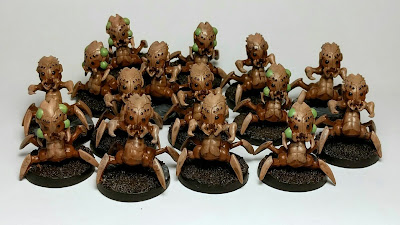 |
| Crawlers |
Looking at the unpainted ones originally, it was hard to tell that there even were different sculpts; painting the ranged crawlers with green poison glands makes them much easier to pick out on the table and in the box. Also, I should mention that with all the figures in this set, I am mostly following the color schemes on the card art. These crawlers were done with light highlighting after the base coat and wash, which gave them a much livelier appearance than before. For the bases, I didn't even flock them, because I wanted them to look like they could be on barren earth or in a cave, and I think it turned out fine.
 |
| Grubbers |
Now, away from the minions and on to the captains!
 |
| Stalkers |
 |
| Muckers |
 |
| Terror with 1,000 Legs |
Back to the insects, I moved on to the Terror with 1,000 Legs—the "big bad" of the Myth base set. Again, lots of two-brush blending over big, curved areas, and I think it looks pretty good. The pale maggots were fun to paint as high-contrast against the red-brown Terror.
One thing you cannot tell from the pictures is that my Terror was quite badly affixed to its base. All the miniatures in Myth come pre-assembled and attached to their bases, and although the assembly is generally good, some of them were poorly attached to the base. The Terror in particular was about 2mm higher on one side than the other. Originally I tried sculpting a base from Milliput to compensate, but it was its left side that was higher—the side with the maggot at ground level. The result, then, was an odd little shelf that held the maggot off the side, and it looked too goofy. I chipped the Milliput away and used my new razor saw to cut the creature right off its base and, together with my files, level off the bottom of the Terror. I pinned the terror to the base in three places and filled the gaps and base with brown-tinted fine pumice gel.
 |
| Terror and its brood |
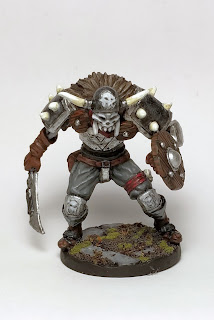 |
| Yardu |
 |
| Yardu |
That's all the villains, so I moved on to the heroes, starting with the two that my son and I were most interested in playing: the Brigand and the Apprentice. Coincidentally, these are the two featured in some of the gameplay videos (starting here) produced by Megacon Games.
 |
| Brigand |
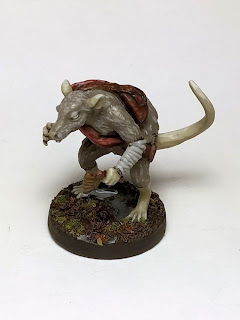 |
| Brigand |
 |
| Brigand |
 |
| Apprentice |
 |
| Apprentice |
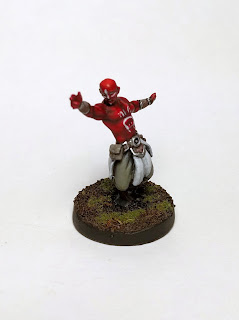 |
| Apprentice |
I don't know if my original figure was bent or not, but the miniature was leaning way back. Looking around at others' figures, it's not clear to me if that was how it was supposed to be or not. In any case, I didn't care for it and I wanted to reinforce the join anyway, so I chopped him off and pinned him back on more upright.
 |
| At the table |
Oh, and I found something in the box when we set up the game:
 |
| A jerk |
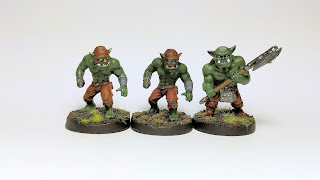 |
| One of these things is not like the other |
 |
| Soldier |
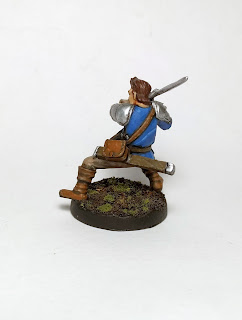 |
| Soldier |
 |
| Soldier |
Back to the painting, I think it turned out nicely. Again, I really like the bold blue combined with the muted browns. The detail is not overdone, which leaves him looking clean.
Notice the really broad stance. Both the Soldier and the Acolyte have wide stances and had their feet molded onto plastic surfboards, which were then pre-assembled to the bases. I thought these looked pretty goofy, and I wasn't sure how to base around them effectively. Turns out, as you can see above, he just barely fits on the regular base, so I chopped off the surfboard and used angled pins to affix him to the base.
 |
| Acolyte |
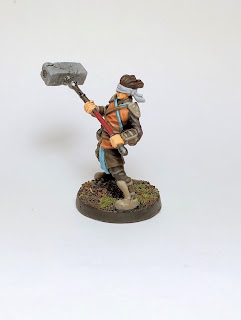 |
| Acolyte |
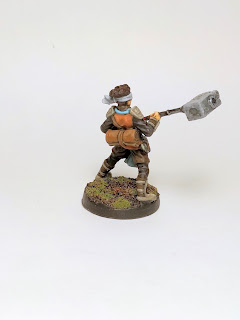 |
| Acolyte |
 |
| Archer |
 |
| Archer |
 |
| Archer |
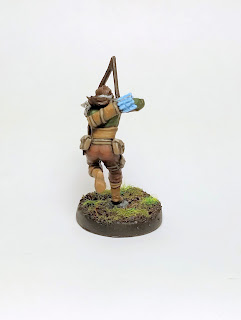 |
| Archer |
In the card art, she is holding her arrow in the conventional manner, on the left side of the bow for a right-handed archer. However, the sculpt has the arrow on the other side. I wonder if the sculptor did this on purpose or just doesn't know the conventions of archery? Maybe he watched Lars Anderson's goofy shooting videos too many times? (Nothing against Anderson, though: I bet my students would listen to me if I had that voiceover guy narrating my programming videos, or if I jumped over obstacles during class.)
 |
| Tricksters |
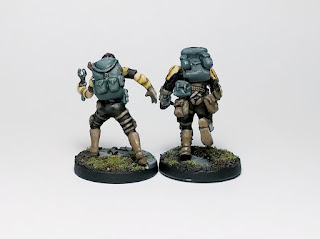 |
| Tricksters |
 |
| All the Heroes |
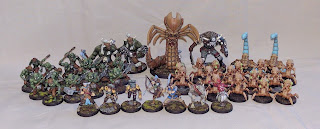 |
| Everybody |
Another thing to like about Myth is the community. There are a ton of resources on Board Game Geek and the official Myth forums. Also, when I posted a rules question to the official forum, I had an answer from one of the designers within 24 hours.
While I am glad for Megacon Games' success via Kickstarter, this is one of those cases where Kickstarter leaves me feeling a little cold. I remember hearing about their first Kickstarter but wasn't even back into painting then, so I wasn't watching for interesting miniature games. Being outside the loop, I didn't hear about the expansion Kickstarter either. Now I don't need more stuff, and I certainly don't need an expansion if we cannot yet complete a single story quest, but I cannot help but look at the incredible deal that the backers got and be a bit jealous. I guess that's the twist on Kickstarter, never quite knowing if it's going to be something you hope it will be or not. I'll just have to hope that their upcoming Kickstarter campaign for Myth: Dark Frontier includes some deals for latecomers like me.
A final note: I met Brian Shotton, lead designer and co-owner of Megacon Games, and he is a fantastic and authentic guy. I'll have more to say that when I write about my current immersive learning project, but suffice it to say, I'm happy to support his endeavors as a game designer and local entrepreneur.
 |
| A crowded tile from that one quest we completed. We'll try again soon. |
Subscribe to:
Posts (Atom)


